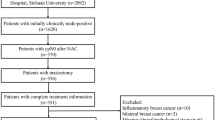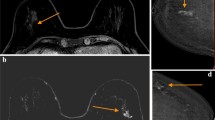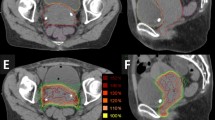Abstract
Objectives
To assess the diagnostic performance of conventional and DW-MRI parameters in the detection of residual tumor in locally advanced cervical cancer (LACC) patients treated with neoadjuvant chemoradiotherapy (nCRT) and radical surgery
Methods
Between October 2010 and June 2014, 88 patients with histologically documented cervical cancer (FIGO stage IB2–IVA) were prospectively included in the study. Maximum tumor diameters (maxTD), tumor volume (TV), DWI signal intensity (SI), and ADCmean were evaluated at MRI after nCRT. Histology was the reference standard. Treatment response was classified as complete (CR) or partial (PR). Comparisons were made with Mann-Whitney, χ2, and Fisher’s exact tests. ROC curves were generated for variables to evaluate diagnostic ability to predict PR and to determine the best cutoff value to predict PR. For each diagnostic test, sensitivity, specificity, and accuracy were calculated.
Results
TV and maxTD were significantly smaller in the CR than in the PR group (p < 0.001; p = 0.001) and showed, respectively, sensitivity of 68.8%, specificity of 72.5%, and accuracy of 70.5% and of 47.9, 87.5, and 65.9% in predicting PR. High DWI SI was more frequent in the PR (81.8%) than in the CR group (55.3%) (p < 0.009). ADCmean was higher in the CR (1.3 × 10-3 mm2/s, range 0.8–1.6 × 10-3 mm2/s) than in the PR group (1.1 × 10-3 mm2/s; range 0.7–1.8 × 10-3 mm2/s) (p < 0.018). High DWI SI showed sensitivity, specificity, and accuracy of 81.8, 44.7, and 64.6% in predicting PR. The ADCmean measurement increased sensitivity, specificity, and accuracy to 75.0, 76.2, and 75.4%.
Conclusions
Conventional and DW-MRI is useful for predicting PR after nCRT in LACC. The ADCmean value ≤ 1.1 × 10-3 mm2/s was the best cutoff to predict PR.
Key Points
• Conventional and DW-MRI is useful for predicting PR after nCRT in LACC.
• The combination of T2 sequences, DW-MRI, and the quantitative measurement of ADC mean showed the best results in predicting pathological PR.
• The best cutoff for predicting pathological PR was ADCmeanvalue ≤ 1.1 × 10-3 mm2/s.






Similar content being viewed by others
Abbreviations
- ADCmean :
-
Apparent diffusion coefficient mean
- CR:
-
Complete response
- CRT:
-
Chemoradiation
- DW-MR:
-
Diffusion-weighted magnetic resonance
- FIGO:
-
International Federation of Gynecology and Obstetrics
- FN:
-
False negative
- FP:
-
False positive
- FRFSE:
-
Fast-recovery fast spin echo
- FSE:
-
Fast spin echo
- IVIM:
-
Intravoxel incoherent motion
- LACC:
-
Locally advanced cervical cancer
- maxTD:
-
Maximum tumor diameters
- nCRT:
-
Neoadjuvant chemoradiotherapy
- PACS:
-
Picture archiving and communication system
- pR0:
-
Absence of any residual tumor
- pR1:
-
Microscopic residual tumor
- pR2:
-
Macroscopic residual tumor
- PR:
-
Partial response
- PRICE:
-
Prospective imaging of cervical cancer and neoadjuvant treatment
- RECIST:
-
Response Evaluation Criteria In Solid Tumors
- ROI:
-
Region of interest
- SE:
-
Spin echo
- SPSS:
-
Statistical Package for the Social Sciences
- TN:
-
True negative
- TP:
-
True positive
- TUS:
-
Transvaginal ultrasound
- TV:
-
Tumor volume
References
Jalaguier-Coudray A, Villard-Mahjoub R, Delouche A et al (2017) Value of dynamic contrast-enhanced and diffusion-weighted MR imaging in the detection of pathologic complete response in cervical cancer after neoadjuvant therapy: a retrospective observational study. Radiology 284:432–442
Fu ZZ, Peng Y, Cao LY, Chen YS, Li K, Fu BH (2015) Value of apparent diffusion coefficient (ADC) in assessing radiotherapy and chemotherapy success in cervical cancer. Magn Reson Imaging 33:516–524
McNeil C (1999) New standard of care for cervical cancer sets stage for next questions. J Natl Cancer Inst 91:500–501
Chemoradiotherapy for Cervical Cancer Meta-analysis Collaboration (CCCMAC) (2010) Reducing uncertainties about the effects of chemoradiotherapy for cervical cancer: individual patient data meta-analysis. Cochrane Database Syst Rev CD008285. https://doi.org/10.1002/14651858.CD008285
Marth C, Landoni F, Mahner S, McCormack M, Gonzalez-Martin A, Colombo N (2017) Cervical cancer: ESMO clinical practice guidelines for diagnosis, treatment and follow-up. Ann Oncol 28:iv72–iv83
Classe JM, Rauch P, Rodier JF et al (2006) Surgery after concurrent chemoradiotherapy and brachytherapy for the treatment of advanced cervical cancer: morbidity and outcome: results of a multicenter study of the GCCLCC (Groupe des Chirurgiens de Centre de Lutte Contre le Cancer). Gynecol Oncol 102:523–529
Ferrandina G, Margariti PA, Smaniotto D et al (2010) Long-term analysis of clinical outcome and complications in locally advanced cervical cancer patients administered concomitant chemoradiation followed by radical surgery. Gynecol Oncol 119:404–410
Motton S, Houvenaeghel G, Delannes M et al (2010) Results of surgery after concurrent chemoradiotherapy in advanced cervical cancer: comparison of extended hysterectomy and extrafascial hysterectomy. Int J Gynecol Cancer 20:268–275
Touboul C, Uzan C, Mauguen A et al (2010) Prognostic factors and morbidities after completion surgery in patients undergoing initial chemoradiation therapy for locally advanced cervical cancer. Oncologist 15:405–415
Gallotta V, Ferrandina G, Chiantera V et al (2015) Laparoscopic radical hysterectomy after concomitant chemoradiation in locally advanced cervical cancer: a prospective phase II study. J Minim Invasive Gynecol 22:877–883
Morice P, Rouanet P, Rey A et al (2012) Results of the GYNECO 02 study, an FNCLCC phase III trial comparing hysterectomy with no hysterectomy in patients with a (clinical and radiological) complete response after chemoradiation therapy for stage IB2 or II cervical cancer. Oncologist 17:64–71
Cetina L, González-Enciso A, Cantú D et al (2013) Brachytherapy versus radical hysterectomy after external beam chemoradiation with gemcitabine plus cisplatin: a randomized, phase III study in IB2-IIB cervical cancer patients. Ann Oncol 24:2043–2047
Ferrandina G, Gambacorta A, Gallotta V et al (2014) Chemoradiation with concomitant boosts followed by radical surgery in locally advanced cervical cancer: long-term results of the ROMA-2 prospective phase 2 study. Int J Radiat Oncol Biol Phys 90:778–785
Gupta S, Maheshwari A, Parab P et al (2018) Neoadjuvant chemotherapy followed by radical surgery versus concomitant chemotherapy and radiotherapy in patients with stage IB2, IIA, or IIB squamous cervical cancer: a randomized controlled trial. J Clin Oncol 36:1548–1555
Chen H, Liang C, Zhang L, Huang S, Wu X (2008) Clinical efficacy of modified preoperative neoadjuvant chemotherapy in the treatment of locally advanced (stage IB2 to IIB) cervical cancer: randomized study. Gynecol Oncol 110:308–315
Selvaggi L, Loizzi V, Di Gilio AR, Nardelli C, Cantatore C, Cormio G (2006) Neoadjuvant chemotherapy in cervical cancer: a 67 patients experience. Int J Gynecol Cancer 16:631–637
González-Martín A, González-Cortijo L, Carballo N et al (2008) The current role of neoadjuvant chemotherapy in the management of cervical carcinoma. Gynecol Oncol 110:S36–S40
Sala E, Rockall AG, Freeman SJ, Mitchell DG, Reinhold C (2013) The added role of MR imaging in treatment stratification of patients with gynecologic malignancies: what the radiologist needs to know. Radiology 266:717–740
Levy A, Medjhoul A, Caramella C et al (2011) Interest of diffusion-weighted echo-planar MR imaging and apparent diffusion coefficient mapping in gynecological malignancies: a review. J Magn Reson Imaging 33:1020–1027
Kim HS, Kim CK, Park BK, Huh SJ, Kim B (2013) Evaluation of therapeutic response to concurrent chemoradiotherapy in patients with cervical cancer using diffusion-weighted MR imaging. J Magn Reson Imaging 37:187–193
McVeigh PZ, Syed AM, Milosevic M, Fyles A, Haider MA (2008) Diffusion-weighted MRI in cervical cancer. Eur Radiol 18:1058–1064
Schreuder SM, Lensing R, Stoker J, Bipat S (2015) Monitoring treatment response in patients undergoing chemoradiotherapy for locally advanced uterine cervical cancer by additional diffusion-weighted imaging: a systematic review. J Magn Reson Imaging 42:572–594
Valentini AL, Miccò M, Gui B et al (2018) The PRICE study: the role of conventional and diffusion-weighted magnetic resonance imaging in assessment of locally advanced cervical cancer patients administered by chemoradiation followed by radical surgery. Eur Radiol 28:2425–2435
Testa AC, Ferrandina G, Moro F et al (2017) Prospective multimodal imaging assessment of locally advanced cervical cancer patients administered by chemoradiation followed by radical surgery. The PRICE (PRospective Imaging of CErvical cancer and neoadjuvant treatment) study: the role of ultrasound. Ultrasound Obstet Gynecol. https://doi.org/10.1002/uog.17551
Testa AC, Moro F, Pasciuto T et al (2017) Prospective multimodal imaging assessment of locally advanced cervical cancer patients administered by chemoradiation followed by radical surgery. The PRICE (PRospective Imaging of CErvical cancer and neoadjuvant treatment) study 2: the role of ultrasound after chemoradiation to assess residual tumor. Ultrasound Obstet Gynecol. https://doi.org/10.1002/uog.18953
Kuang F, Yan Z, Wang J, Rao Z (2014) The value of diffusion-weighted MRI to evaluate the response to radiochemotherapy for cervical cancer. Magn Reson Imaging 32:342–349
Therasse P, Arbuck SG, Eisenhauer EA et al (2000) New guidelines to evaluate the response to treatment in solid tumors. J Natl Cancer Inst 92:205–216
Querleu D, Morrow CP (2008) Classification of radical hysterectomy. Lancet Oncol 9:297–303
Zannoni GF, Vellone VG, Carbone A (2008) Morphological effects of radiochemotherapy on cervical carcinoma: a morphological study of 50 cases of hysterectomy specimens after neoadjuvant treatment. Int J Gynecol Pathol 27:274–281
Vincens E, Balleyguier C, Rey A et al (2008) Accuracy of magnetic resonance imaging in predicting residual disease in patients treated for stage IB2/II cervical carcinoma with chemoradiation therapy : correlation of radiologic findings with surgicopathologic results. Cancer 113:2158–2165
Gui B, Valentini AL, Miccò M et al (2016) Cervical cancer response to neoadjuvant chemoradiotherapy: MRI assessment compared with surgery. Acta Radiol 57:1123–1131
Flueckiger F, Ebner F, Poschauko H, Tamussino K, Einspieler R, Ranner G (1992) Cervical cancer: serial MR imaging before and after primary radiation therapy—a 2-year follow-up study. Radiology 184:89–93
Mayr NA, Taoka T, Yuh WT et al (2002) Method and timing of tumor volume measurement for outcome prediction in cervical cancer using magnetic resonance imaging. Int J Radiat Oncol Biol Phys 52:14–22
Ebner F, Kressel HY, Mintz MC et al (1988) Tumor recurrence versus fibrosis in the female pelvis: differentiation with MR imaging at 1.5 T. Radiology 166:333–340
Chen J, Zhang Y, Liang B, Yang Z (2010) The utility of diffusion-weighted MR imaging in cervical cancer. Eur J Radiol 74:e101–e106
Liu Y, Bai R, Sun H, Liu H, Zhao X, Li Y (2009) Diffusion-weighted imaging in predicting and monitoring the response of uterine cervical cancer to combined chemoradiation. Clin Radiol 64:1067–1074
Naganawa S, Sato C, Kumada H, Ishigaki T, Miura S, Takizawa O (2005) Apparent diffusion coefficient in cervical cancer of the uterus: comparison with the normal uterine cervix. Eur Radiol 15:71–78
Padhani AR, Liu G, Koh DM et al (2009) Diffusion-weighted magnetic resonance imaging as a cancer biomarker: consensus and recommendations. Neoplasia 11:102–125
Nougaret S, Tirumani SH, Addley H, Pandey H, Sala E, Reinhold C (2013) Pearls and pitfalls in MRI of gynecologic malignancy with diffusion-weighted technique. AJR Am J Roentgenol 200:261–276
Levy A, Caramella C, Chargari C et al (2011) Accuracy of diffusion-weighted echo-planar MR imaging and ADC mapping in the evaluation of residual cervical carcinoma after radiation therapy. Gynecol Oncol 123:110–115
Wang YC, Hu DY, Hu XM et al (2016) Assessing the early response of advanced cervical cancer to neoadjuvant chemotherapy using Intravoxel incoherent motion diffusion-weighted magnetic resonance imaging: a pilot study. Chin Med J (Engl) 129:665–671
Inoue C, Fujii S, Kaneda S et al (2013) Apparent diffusion coefficient (ADC) measurement in endometrial carcinoma: effect of region of interest methods on ADC values. J Magn Reson Imaging 40:157–161
Funding
The authors state that this work has not received any funding.
Author information
Authors and Affiliations
Corresponding author
Ethics declarations
Guarantor
The scientific guarantor of this publication is Prof. Anna Lia Valentini.
Conflict of interest
The authors declare that they have no competing interests.
Statistics and biometry
One of the authors has significant statistical expertise.
Informed consent
Written informed consent was obtained from all subjects (patients) in this study.
Ethical approval
Institutional review board approval was obtained.
Study subjects or cohorts overlap
Some study subjects or cohorts have been previously reported in three other articles. Two of these studies analyze exclusively US parameters (“Prospective multimodal imaging assessment of locally advanced cervical cancer patients administered by chemoradiation followed by radical surgery. The PRICE (PRospective Imaging of CErvical cancer and neoadjuvant treatment) study: the role of ultrasound” and “Prospective multimodal imaging assessment of locally advanced cervical cancer patients administered by chemoradiation followed by radical surgery. The PRICE (PRospective Imaging of CErvical cancer and neoadjuvant treatment) study 2: the role of ultrasound after chemoradiation to assess residual tumor”). The third study analyzes the role of DW-MRI in the early prediction of tumor response (“The PRICE study: the role of conventional and diffusion-weighted magnetic resonance imaging in assessment of locally advanced cervical cancer patients administered by chemoradiation followed by radical surgery”).
Methodology
• Prospective
• Diagnostic or prognostic study
• Performed at one institution
Electronic supplementary material
ESM 1
(DOCX 20 kb)
Rights and permissions
About this article
Cite this article
Gui, B., Miccò, M., Valentini, A.L. et al. Prospective multimodal imaging assessment of locally advanced cervical cancer patients administered by chemoradiation followed by radical surgery—the “PRICE“ study 2: role of conventional and DW-MRI. Eur Radiol 29, 2045–2057 (2019). https://doi.org/10.1007/s00330-018-5768-5
Received:
Revised:
Accepted:
Published:
Issue Date:
DOI: https://doi.org/10.1007/s00330-018-5768-5




